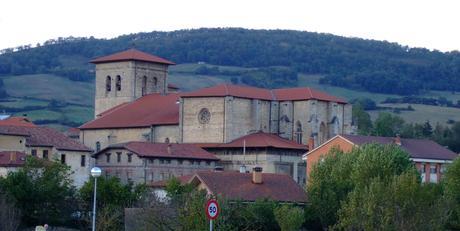.
Of course, the city of Orduña didn’t need this chapter in my series The Basque trail for being well known in the country, as its beauty, along with its landscape diversity, and even its climate, by their own right play an outstanding role in this part of Spain. But then, a travel journal about the Basque Country wouldn’t be complete without the Orduña route.
Indeed, as was written by the Spanish geographer Madoz around 1840: seven leagues away from Bilbao and six from Vitoria, Orduña is the only city in the province of Biscay. It’s placed on the flat slope of La Peña, where a grassland spreads out 3/4 of a league’s wide and 5/4 long, splendid, fertile and beautiful; climate is mild and very healthy, and most common diseases are rheumatism and common cold[...] Among others, chacolí wine is produced which could outdo that from Bordeaux, if only it were better elaborated. I don’t know how Orduña chacolís were by 1840, but nowadays’ Bordeaux must needs be quite good for not being outdone by ours: as I’ve had the chance of learning along my little trip, extremely tasty wines are fermented in this city. As my readers (if there’s any) already know, wine always plays a main role in my rides… up to where the traffic law allows me.
But let’s kick start, because we’re about to begin one of the finest motorcycle journeys you can take in the Basque region: same the road to Orduña as the city itself, and its surroundings, are good from start to finish. Exiting Vitoria by route N-622, we’ll leave the double laned highway at Izarra, hence taking the bucolic local road A-2521, where the true route begins through invigorating natural settings.

Artistic milestone under the oaks’ overseeing shades
Little far from the aforementioned junction I pass through a shady and damp grove of oaks and ferns, inviting to get into it for the search of goblins and leyends. Someone, in those times where things were made to last, marked out the road with worthy handcrafted milestones like this in the picture. Yet a little further, past the grove, among fertile prairies some hamlets lie, specking with terracotta shades the greenish colours of the sunny basin. I make a halt in one of them, maybe Goluri, where I park the bike and take a stroll for making some pictures. Behind the church, the peasants have built a fine bolategui (a long sheltered board lane for playing a typical Basque ball game), along whose side they pile wood for warming up their games and gatherings during the long winter months.

Goyuri’s Bolategui

Bolategui inside
A mile further, the ancient tower of a solitary chapel by the road, outstanding the treetops, makes me stop again. Since my youth, the retreat of these lonely shrines or hermitages has always awakened my emotions, and it’s but with reverence that I approach or contemplate them. By its northern side there is a small graveyard with the tombs, I reckon, of the valley inhabitants who worked its land and chopped down its trees. Requiescant in pace.

Goluri’s shrine, nearby the road

Graveyard behind Goluri’s shrine
Cottages or chapels, though, aren’t the only treasures to be found by the traveler heading for Orduña, but also breathtaking landscapes suddenly coming out behind a turn of the road. Thus, after the last stretch of pavement cuts those prairies like a knife, past a bend there appears the superb, astounding rocky walls of the valley where the Nervión river springs, and on whose bed rises the city we’ve come to visit. Along the ridge of those mountains lies the border dividing Biscay from Burgos.

Nervión’s upper valley. Burgos beyond the mountains.
The sharp cuts made on the rock by the ice, millions of years ago, forming the upper valley of the Nervión, disappear in the distance.

Nervión’s glaciel valley.
Now it’s time for having some fun with the motorcycle: here the descent starts along sharp bends of the road taking us to the valley bed, and rounding off with a beautifully balanced final stretch, lined by trees, which leads into Orduña.

Tree flanked stretch leading into Orduña.
Our first sight of the city: the robust and warlike profile of Saint Mary’s church-fortress, which once integrated the walls fending Orduña off its enemies along the many fights in its history.

Saint Mary’s church-fortress of the warlike built.

